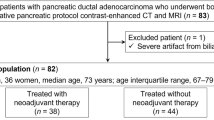Abstract
The optimal preoperative evaluation of periampullary neoplasms remains controversial. The aim of this study was to analyze the accuracy of helical computed tomography (CT) and CT angiography with three-dimensional reconstruction in predicting resectability. Between March 1996 and May 1999, a total of 100 patients with periampullary neoplasms were prospectively staged by helical CT and CT angiography with three-dimensional reconstruction. Vascular involvement was graded from 0 to 4, with grade 0 representing no vascular involvement and grade 4 total encasement of either the superior mesenteric vein or artery. Patients with grade 4 lesions were considered unresectable. Sixty-eight patients underwent surgical exploration with intent to perform a pancreaticoduodenectomy. Forty-four lesions were grade 0, five were grade 1, eight were grade 2, and 11 were grade 3. Resectability for grades 0 to 3 was 96%, l00%, 50%, and 9%, respectively, for an overall resectability rate of 76%. Resectability in patients with vascular encroachment (grade 2) is usually determined by the extent of local disease rather than the presence of extrapancreatic disease. Resection is rarely possible in patients with evidence of vascular encasement (grade 3). Additional imaging modalities such as diagnostic laparoscopy are superfluous in patients with no evidence of local vascular involvement on CT angiography (grades 0 and 1) because of the high resectability rate and infrequency of unsuspected distant metastatic deposits.
Similar content being viewed by others
References
Conlon KC, Klimstra DS, Brennan ME. Long-term survival after curative resection for pancreatic ductal adenocarcinoma. Clinicopathologic analysis of S-year survivors. Ann Surg 1996; 223:273–279.
Yeo CJ, Cameron JL, Sohn TA, et al.. Six hundred fifty con- secutive pancreaticoduodenectomies in the 1990s: Pathology, complications, and outcomes. Ann Surg 1997;226:248–257.
Warshaw AL, Gu ZY, Wittenberg J, Waltman AC. Preopera- tive staging and assessment of resectability of pancreatic can- cer. Arch Surg 1990;125:230–233.
Gallery MP, Strasberg SM, Doherty GM, et al.. Staging lapa- roscopy with laparoscopic ultrasonography: Optimizing re- sectability in hepatobiliary and pancreatic malignancy. J Am Co11 Surg 1997;185:33–39.
Bemelman WA, de Wit LT, van Delden OM, et al.. Diagnos- tic laparoscopy combined with laparoscopic ultrasonography in staging of cancer of the pancreatic head region [see com- ments]. Br J Surg 1995;82:820–824.
Raptopoulos V, Steer ML, Sheiman RG, et al.. The use of he- lical CT and CT angiography to predict vascular involvement from pancreatic cancer: Correlation with findings at surgery. AJR Am J Roentgen01 1997;168:971–977.
Fuhrman GM, Leach SD, Staley CA, et al.. Rationale for en bloc vein resection in the treatment of pancreatic adenocarci- noma adherent to the superior mesenteric-portal vein conflu- ence. Pancreatic Tumor Study Group. Ann Surg 1996;223:154–162.
Leach SD, Lee JE, Charnsangavej C, et al.. Survival following pancreaticoduodenectomy with resection of the superior mesenteric-portal vein confluence for adenocarcinoma of the pancreatic head. Br J Surg 1998;85:611–617.
Harrison LE, Klimstra DS, Brennan ME. Isolated portal vein involvement in pancreatic adenocarcinoma. A contraindica- tion for resection? Ann Surg 1996;224:342–347.
Lichtenstein DR, Carr-Locke DL. Endoscopic palliation for unresectable pancreatic carcinoma. Surg Clin North Am 1995;75:969–988.
Smith AC, Dowsett JF, Russell RC, et al.. Randomised trial of endoscopic stenting versus surgical bypass in malignant low bileduct obstruction. Lancet 1994;344:1655–1660.
Friess H, Kleeff J, Silva JC, et al.. The role of diagnostic lapa- roscopy in pancreatic and periampullary malignancies. J Am Coil Surg 1998;186:675–682.
Conlon KC, Doughertv E, Klimstra DS, et al.. The value of minimal access surgeryfiin the staging of patients with poten- tially resectable peripancreatic malignancy. Ann Surg 1996; 223:134–140.
Freeny PC, Traverso LW, Ryan JA. Diagnosis and staging of pancreatic adenocarcinoma with dynamic computed tomog- raphy. Am J Surg 1993;165:600–606.
McCarthy MJ, Evans J, Sagar G, Neoptolemos JP. Prediction of resectability of pancreatic malignancy by computed to- mography. Br J Surg 1998;85:320–325.
Furukawa H, Kosuge T, Mukai K, et al.. Helical computed tomography in the diagnosis of portal vein invasion by pancre- atic head carcinoma: Usefulness for selecting surgical proce- dures and predicting the outcome. Arch Surg 1998;133:61–65.
Andren-Sandberg A, Lindberg CG, Lundstedt C, Ihse I. Computed tomography and laparoscopy in the assessment of the patient with pancreatic cancer. J Am Co11 Surg 1998; 186:35–40.
John TG, Greig JD, Carter DC, Garden OJ. Carcinoma of the pancreatic head and periampullary region. Tumor staging with laparoscopy and laparoscopic ultrasonography. Ann Surg 1995;221:156–164.
Holzman MD, Reintgen KL, Tyler DS, Pappas TN. The role of laparoscopy in the management of suspected pancreatic and periampullary malignancies. J GASTROINTEST SURF; 1997;l:236–244.
Bluemke DA, Cameron JL, Hruban RH, et al.. Potentially re- sectable pancreatic adenocarcinoma: SpiraI CT assessment with surgical and pathologic correlation. Radiology 1995;197:381–385.
Minnard EA, Conlon KC, Hoos A, et al.. Laparoscopic ultra- sound enhances standard laparoscopy in the staging of pan- creatic cancer. Ann Surg 1998;228:182–187.
Legmann P, Vignaux 0, Dousset B, et al.. Pancreatic tumors: Comparison of dual-phase helical CT and endoscopic sonog- raphy. AJR Am J Roentgen01 1998;170:1315–1322.
Author information
Authors and Affiliations
Corresponding author
Rights and permissions
About this article
Cite this article
Saldinger, P.F., Reilly, M., Reynolds, K. et al. Is CT angiography sufficient for prediction of resectability of periampullary neoplasms?. J Gastrointest Surg 4, 233–239 (2000). https://doi.org/10.1016/S1091-255X(00)80071-2
Issue Date:
DOI: https://doi.org/10.1016/S1091-255X(00)80071-2




